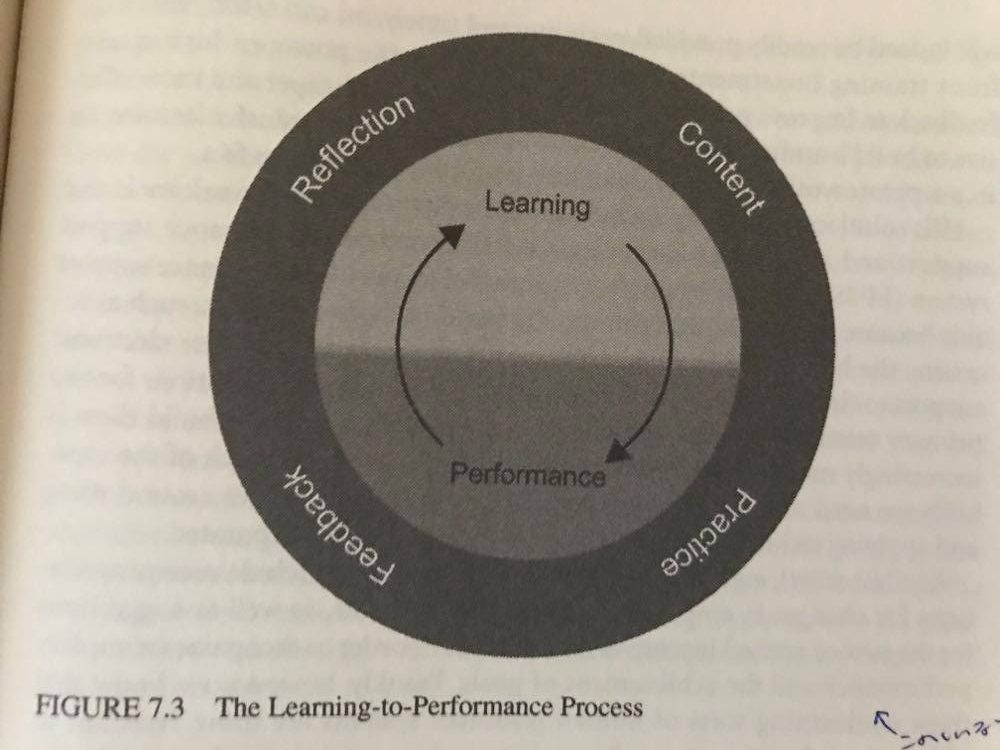
○R.ブリンカーホフ先生の初期の本(1983、1994、2001)。ブリンカーホフ先生が、何故、SCMを提唱したのかの流れが見える気がします。
===
『Program Evaluation~A Practioner’s Guide for Trainers and Educators』
Brinkerhoff,R.O.,Brethower,D.M.,Hluchyj,T.,& Nowakowski,J.R.(1983) Kluwer・Nijhoff Publishing
・Evaluation Training Consortium(ETC)Projectが、1972年から1982年まで実施された。
・Evaluationという言葉を使う時は、定義を含め、10の問いを考えるべきである。
・Scriven(1967)が、初めて、形成的、総括的評価を区分した。更に3つ目の評価の目的として、心理的、社会-政治的なものがある(注目を集める、対象者の動機付け等)
○Scriven(1967)を読んでみよう。
・障害を持つ子どもへの教育。
・ジョンソン大統領が、社会福祉、教育に焦点を当てた。
・7つの評価活動
1)評価への焦点
2)評価の設計
3)情報の収集
4)分析と解釈
5)報告
6)管理
7)メタ評価
・サンプリングは、母集団の一部を見るもの。言ってみれば近道。
・2種類のサンプリング:Random無作為、Purposive作為的、意図的?
・Alkin(1978)は、評価報告は、評価者と聞き手との間に、対話が生まれると、最も効果的であると述べている。
・評価にかける予算は、プログラム・プロジェクト予算の10%が一つの目安である。
・評価は、関わる人々にとっての学習経験になるべきである。そのために、評価の評価(メタ評価)が必要。
===
『THE LEARNING ALLIANCE: SYSTEMS THINKING IN HUMAN RESOURCE DEVELOPMENT』
Brinkerhoff,R.O. & Gill, S.J. (1994) Jossey-Bass.
“Many training leaders are still working within the old paradigm.”
・多くの研修リーダーたちは、古いパラダイムの中にいる。
“Powerful new training approaches, with “”just-in-time”” and “”just-enough”” learning designs,”
・新しい強力な研修アプローチは、ちょうどよい時期に、ちょうどよい分量の学習設計である。
“conceptualization of training as a discrete event,”
・研修を個別のイベントとして見る概念
“training is viewed and managed as a process within a system”
・研修をシステムの中にあるプロセスとして見て、管理する。
“shift in thinking is from departmentalization to interdependence, from program to process, from quick fix to analytic solutions, from short-term results to long-term results, from costly change to leveraged change, and from blaming the system to owning the system. “
・部署から相互依存、プログラムからプロセス、素早い固定(型どおり)から分析的解決策、短期から長期成果、コスト変化からレバレッジ変化、システムへの文句からシステムのオーナーへという思考のシフトが必要。
“From 1975 until 1983 Brinkerhoff directed the Evaluation Training Consortium for the Bureau of Education for the Handicapped.”
○この時、書いた本が『Program Evaluation』(1983)
“highly effective training (HET). It has four subprocesses: “
・HETの4つのサブプロセス
“single largest expense of training, which is the cost of the time that trainees spend in learning activities, is of no value to the organization. “
・研修の最大のコストは、受講者が組織に価値をもたらしていない、学習活動に費やしている時間である。
“Transfer of learning to the job was low; sometimes less than 5 percent of trainees claimed to have used their training on the job. “
・学習内容の仕事への転移は低い。5%以下が、研修内容を仕事に使っている。
“We must build the capacity of organizations to learn.”
・組織が学習できる能力を作るべき。
“Today’s reality is more aptly described as continuing crisis.”
・今の現実は(昔と違い)「継続的な危機」という表現のほうがふさわしい。
“The workplace can untrain people far more efficiently than even the best training department can train people. “
・最高の研修部門が人々を訓練するよりも、職場は効率的に人々を非訓練する(もとに戻してしまう)
“The typical corporate training program produces only about a 10 to 20 percent return when return is based upon an estimate of the trainees who will actually end up using the training in their jobs.”
・受講者が研修を仕事で使うかどうかでリターンを測定するとしたなら、一般的な会社の研修が造り出しているリターンは10~20%ぐらいだろう。
“The problem is larger and more systemic.”
・問題は、もっと大きく、システミックなものである。
“vision for training is always the same: to add value to organizational products and services.”
・研修のビジョンは常に一緒である:組織の商品・サービスに価値を付け加えることである。
“process approach to training and its four subprocesses.”
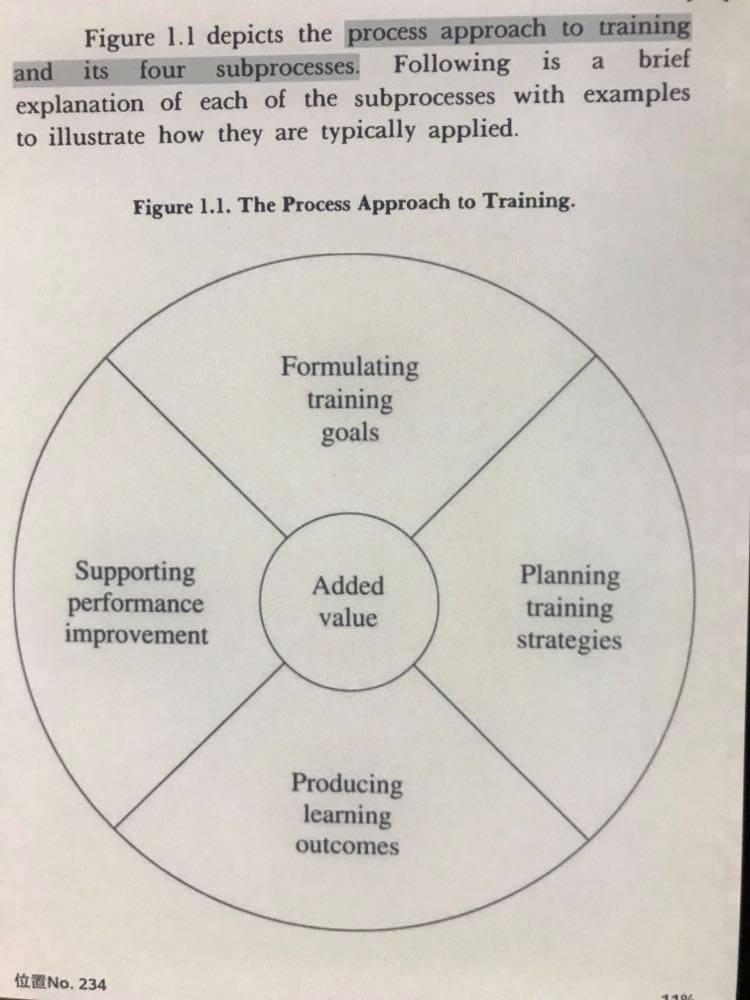
“Trainers and their departments typically define their role in such a way that once trainees exit a learning event, they are “”on their own”” and the actual use of the training becomes someone else’s responsibility. “
・学習イベントから受講者が出ていった後は、研修内容を活用するかどうかは「誰か他の人の責任」というのが、講師や研修部門が考える自分たちの役割だろう。
“HET is to conceptualize, design, and implement training as an integrated system”・HETは、研修を統合されたシステムの中に位置づけ、設計し、実装するものである。
“The key to HET is systems thinking: the assumption that training has an interdependent, dynamic relationship with other business processes and the total organization.”
・HETのカギは「システム思考」である。研修は、相互依存的、動的な関係が、他のビジネスプロセスや組織全体とあるという前提を置くのである。
“there would be no such thing as training programs.”
・研修プログラムなどといったものは存在しない。
“separation between learning and job performance”
・学習と仕事パフォーマンスの分離
“training transfer and training follow-up are indicative of the problems created by the old method.”
・研修転移と研修のフォローアップは、古い手法によって生み出された問題ともいえる。
“HET approach, training is viewed as a process that is significantly larger”
・HETアプローチでは、研修をより大きなシステムの中のプロセスとして捉える。
“five major training myths.”
・研修に関する「5つの神話」
“Myth 1. Training Makes a Difference “
・1)研修が違いを作る
“The experiences that they had before and after the workshop made the difference.”
・研修前と後に彼ら(JanとMichaelのケース)が経験したことが、違いを作っている。
“Myth 2. Training’s Purpose Is to Achieve Learning Objectives “
・2)学習目標を達成することが研修の目的
“training industry is focused on achieving learning objectives, not business objectives.”
・研修業界は、ビジネス目標ではなく、学習目標の達成に焦点を当てている。
“Myth 3. The Trainer’s Purpose Is to Manage Successful Training Programs “
・3)研修プログラムを成功裏に管理することが、講師の目的である。
“Practitioners become certified to lead specific training programs. Companies buy training programs and the licenses to deliver these programs internally.”
・特定の研修プログラムの講師として認定を受ける。企業は研修プログラムのライセンスを買って、社内で運用する。
“Myth 4. Training Is Training’s Job “
・4)研修は、研修部門の仕事である。
“thought of as a place where people who have some deficiency in their knowledge or skills or performance are sent to be “”fixed.”
・研修とは、知識、スキル、パフォーマンスに欠ける人々が送り込まれ「治される」場所だと思われている。
“learning occurs on the job, by trial and error, by watching other people in similar jobs, by “”instruction”” from coworkers, by coaching from supervisors.”
・学習は、仕事を通じて、試行錯誤や、同僚を観察したり、指導を受けたり、上司からコーチングされたりすることを通じて起こる。
“myth that training is the sole purview of training specialists and a training department.”
・研修の専門家や研修部門のみが研修を行うという神話。
“Myth 5. Trainees Should Enjoy the Training They Receive “
・5)受講者は、彼らが受けている研修を楽しむべきである。
“trend toward training that entertains and pleases the trainee.”
・受講者を喜ばせ楽しませるような研修のトレンド
“it is much easier, and safer politically, to measure trainee attitudes toward the event than to provide upper management with information “
・上級管理職に情報提供するよりも、受講者の反応を測定したほうが、より簡単で政治的に安全である。
“training staff spend little time interacting with their management customers.”
・研修スタッフは、研修の顧客であるマネジメント層との交流が殆どできていない。
“training sessions that are simply too loaded with content.”
・コンテンツが多すぎる研修セッションが多い。
“The supervisors of trainees are typically thought of as the enemy.”
・受講者の上司は、「敵」と見られている。
“The impact map is a tool for keeping a clear focus on results.”
・インパクトマップは、成果にはっきりと焦点をあてるツールである。
“The impact map inquiry process provides an opportunity for a dialogue and a flow of information that can help stakeholders learn about processes within their own organizations.”
・インパクトマップは、ステークホルダーたちが、自分の組織でどんなプロセスがあるのかを学ぶ貴重な対話機会を提供する。
“Trainees are often seen as the primary customers. We disagree with this notion.”
・受講者が重要な顧客と見られるが、我々はこの見方に反対する。
“training leaders must keep both internal and external customers in focus at all times if training is to be successful. “
・研修リーダーは、内部、外部顧客の両方を維持する必要がある。
“The systems view is a recognition that elements and actions in organizations are interdependent.”
・システム視点では、組織の中での部分や活動は相互依存的であると考える。
“Managing training from a systems perspective is not easy.”
・システム視点で、研修を管理することは、それほど簡単ではない。
“The first principle of the new approach to performance improvement is to link training to the business goals and strategies of the organization.”
・研修とビジネスゴール、そして組織戦略と結びつけることが、新しいパフォーマンス向上アプローチの第一原則である。
“so many customers of training and their needs are not always the same.”
・研修には沢山の顧客がいて、彼らのニーズは常に同じではない。
“many customer needs are less apparent.”
・多くの顧客ニーズは、見えにくい。
“Training is not a product; it is a service.”
・研修は、商品ではなく、サービスである。
“In performance improvement systems, the core service is learning.”
・パフォーマンス向上システムにおいて、核となるサービスは、学習である。
“learning alone adds little value,”
・ただ、学習だけでは、少しの価値しか加わらない。
“solving employees’ performance and business problems.”
・従業員のパフォーマンスとビジネス問題を解決する。
“systems thinking is a simple logic that anyone can use to manage the complexities of life.”
・システム思考は、複雑な人生を管理するために誰でも使えるシンプルなロジックである
“All systems are influenced by the systems around them.”
・全てのシステムは、それらを取り囲むシステムの影響を受けている。
“external components typically have a greater impact on the achievement of training goals than do the internal components.”
・内的よりも外的要素のほうが、研修ゴールの達成に強い影響を及ぼす。
“The most powerful training force is the organization itself-not the training department.”
・研修部署ではなく、組織が最も強い影響力を研修に対して持っている。
・Senge(1990)の11の「システムの法則」の内、5つ
“Today’s problems come from yesterday’s ‘solutions’
・1)昨日の解決策により、今日の問題が生まれる
“The harder you push, the harder the system pushes back”
・2)強く推すと、システムは強く押し返してくる。
“Behavior grows better before it grows worse”
・3)行動は悪くなる前に、いったんよくなる。
“The easy way out usually leads back in”
・4)
“The cure can be worse than the disease”
・5)病気よりも、治療の方が酷い
“In the past, managers were promoted because they had the technical skills to solve”
・過去、マネジャーは、問題解決できる技術スキルにより昇進した。
“The new role for managers was to empower lab workers.”
・マネジャーの新しい役割は、従業員を勇気づけることである。
“Highly effective training uses program evaluation as a tool for continuous improvement.”
・HETでは、プログラム評価を継続的向上のツールとして使う。
“Measuring the learning event without considering the system in which that event occurs, is like diagnosing an illness by just taking a person’s temperature. “
・イベントが起こったシステムを見ずに、学習イベントのみを測るのは、病気の診断で体温しか見ないのと同じである。
,”Measure to Improve the Process, Not to Blame or Punish “
・プロセス向上のための測定であり、辱めたり、罰を与えたりするためのものではない。
===
『High Impact Learning』
Brinkerhoff,R.O.& Apking,A.M.(2001)Basic Books.
・研修をイベントと捉えるアプローチから、パフォーマンスに軸を置いたアプローチへのシフトを。
・成功する研修を実施することではなく、ゴールは、参加者が学び、仕事をより良く行うことである。
・研修は手段でしかない。
・能力ある(つまりよく訓練された)従業員は、より効果的に仕事をする。
・Technology-enabled learning Eラーニング等 非同期型
Classroom learning 教室型研修 同期型
・教室型によって、安全な環境でスキルを練習出来たり、参加者同士の社会的交流を促すことで、仲間としての一体感を持たせたりすることができる。
・教室型研修のパラダイムにより、研修前、研修中、研修後と考える。これは当時(1990年代)なら良かったが、今は変わるべきだ。
・Eラーニング等を活用することにより、学習プロセスは、継続的なものとなる。
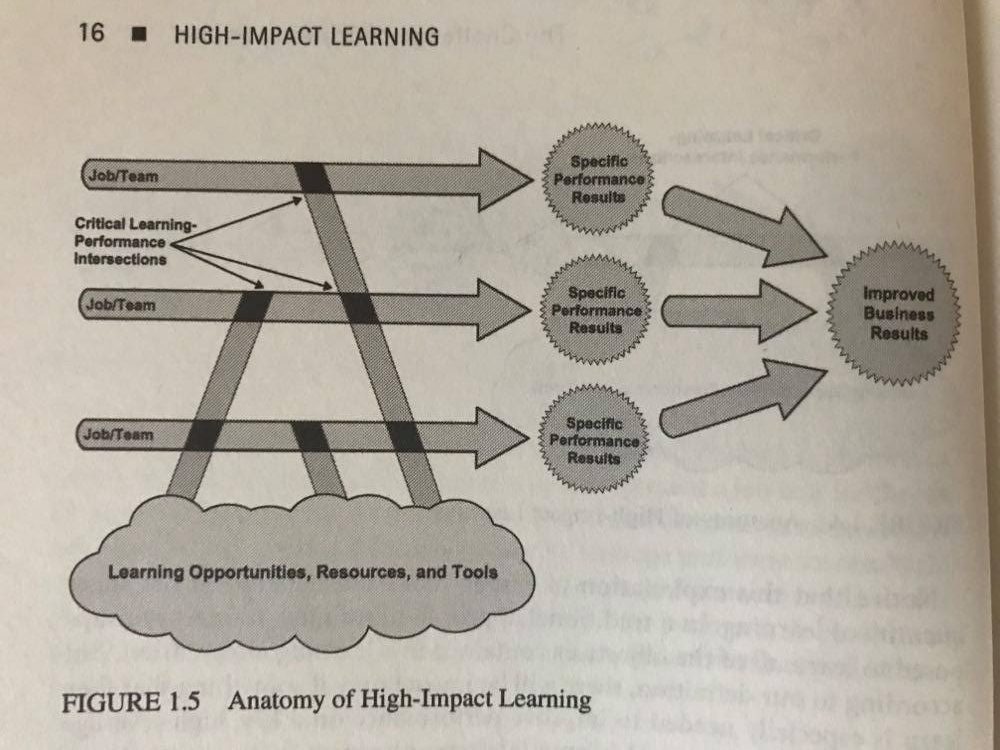
・High Impact Learning:HILの5つの原則
1)戦略的レバレッジ
2)ビジネスとのつながり
3)学習-パフォーマンスのプロセス
4)パフォーマンス支援システムとの統合
5)絶妙な学習解決策 exquisite learning solutions
・Impact Mapsは、1994年の「The Learning Alliance」で初めて紹介した。
・学習が、Impact成果に、いかにつながるかを見える化するもの。
・インパクトマップの核となる構造は、以下のとおりである。
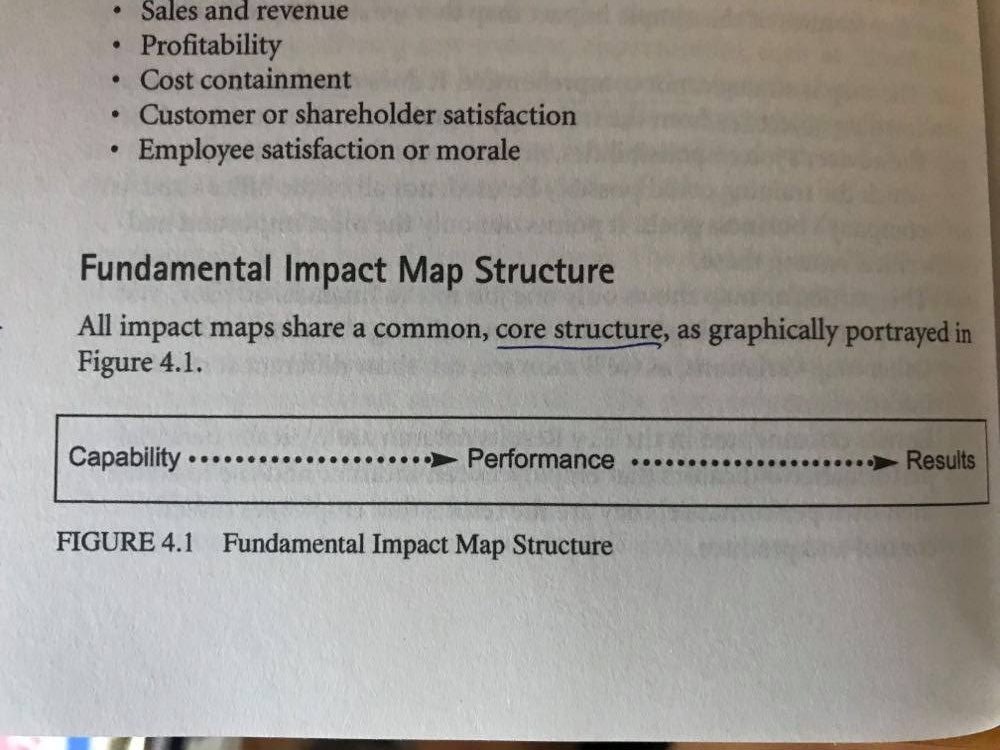
・能力→実行?→成果
・インパクトマップを作る過程において、
成果に向かう質問は「何故、それが重要なのか?」であり
能力に向かう質問は「どうやってやるのか?」である。例を尋ねよ。
・Learner Intentionality 学習者の意図、志向
・研修前に、上司と受講者が30分、研修内容について会話し、受講者の意図を明確化することで、研修転移の度合いが高くなった。
・伝統的なIDだと、研修プログラムが、学習目標を持つ。
HILの場合、受講者個人が、自信の学習目標およびパフォーマンス適用目標(どのように仕事に活かすか)を持つ。
・One-size-fits-all 1つのサイズで全てに合わせるアプローチは、誰とも合わない。
・研修がビジネスといかに結びつくかを、上司と話すことで、従業員の意図、志向性は高まる。
・成人教育学者 M.ノールズ「成人学習者:無視された存在」(1990)では、6つのガイドラインが紹介されている:
1)明確で関連した「知る必要性」
2)学習経験を、自分でコントロールできる
3)経験への尊重
4)学習の準備が必要
5)学習の有用度を知りたい
6)モチベーションを高める何かと学習を結び付けたい
・効果的な学習に含まれるべき4つの要素:
1)Content 内容
2)Practice 練習
3)Feedback 指摘
4)Reflection 内省
・学習→実行のプロセス

○これいいな~。シンプルで本質をついている。
・ISD:Instructional Systems Designは、第二次世界大戦中、多くの兵士や軍人を訓練する必要性により、軍隊で開発された。
・R.ガニェ(1974)により「ADDIE」プロセスが提唱された。
・ADDIEの問題点:
1)遅すぎる
2)実際の設計プロセスは、直線的ではない
3)ADDIEにより、凝り過ぎた解決策になってしまう
4)評価すれば終わりとなってしまう
・HILは、サイクルモデルである。
・伝統的な4レベル研修評価フレームワークは、カークパトリック(1976)で紹介された。最近では、J.フィリップス(1997)が、ROIを加えたレベルを提唱している。
・パートナーシップ戦略では、「研修を我々だけでは出来ない。皆さん(他のステークホルダー)がいなければ、研修は成功しない」というメッセージを送るのである。
・ところが、4レベルやROIアプローチでは、違うメッセージが送られてしまう。
・4レベルでは、研修は「レベル1」「レベル2」にしか当てはまらない。
・「レベル3」「レベル4」は、もはや「研修」を評価していない。より大きなパフォーマンス向上システムを評価しているのである。その中で、研修は小さな役割しかもっていない。
・Impact evaluationとROI評価は、古くからある量的研究手法と実験デザインを基にしており、そこでは「何とか、単独の研修効果を分離させよう」としている。
・しかし、パートナーシップ戦略は、システム思考で考えると、これは不毛な取り組みと言える。
・研修部門は既に長い間、組織から地理的に分離した状態にある。これ以上、自分たちを分離させてどうするのか。もっとビジネスパフォーマンスに入り込むことが必要ではないか。
・大きなパフォーマンスシステムを無視しているのだ。
・もし転移を評価したいなら、研修ではなく、マネジメント(職場管理)とパフォーマンスシステムを評価する必要があるのだ。
・組織がいかに「上手に研修を使っているのか」が重要な問い。
・研修評価は、Defensive防衛的なものではない。パフォーマンスとビジネス成果を向上させるツールが評価なのである。
・学習とパフォーマンスは「Inseparability 分かちがたい」というメッセージを送るのだ。
・Success Case Evaluation サクセスケース評価
・ランダムサンプリングではなく、Purposive 恣意的なサンプリング手法である。
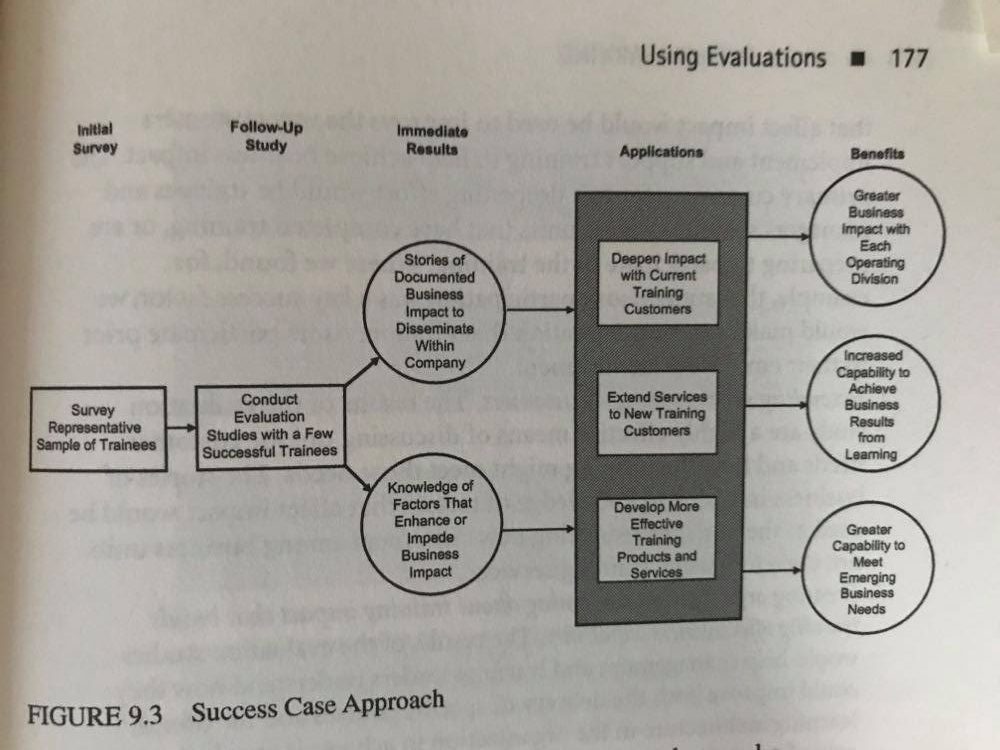
・リアルで、文章化された経験だからこそ、信頼され、行動可能なものと受け止められるのだ。
・1年以上たっていない研修の参加者に、短いサーベイ調査を行う。
・3グループに分かれる:
1)トップ10~15%の熱心が研修活用者
2)殆どインパクトがない参加者
3)その他大勢
・1)については、電話インタビューをして、本当にその人が「研修活用者」なのかを確認した上で、深いインタビューに入っていく。
・2)については、何故、研修を活用しなかったのかを聞いていく
・個人と組織のニーズのバランス
・「研修とは、イベントのデリバリーである」というメンタルモデルを払拭すべき。
・HILでは、少なくとも、3~6か月のタイムスパンで考える。学習だけでなく、パフォーマンスに焦点を当てる為である。
・レベル1で、満足度をとるなら、研修実施者は、満足度を高めるために必死になるだろう。
===
参考:
===

コメントフォーム